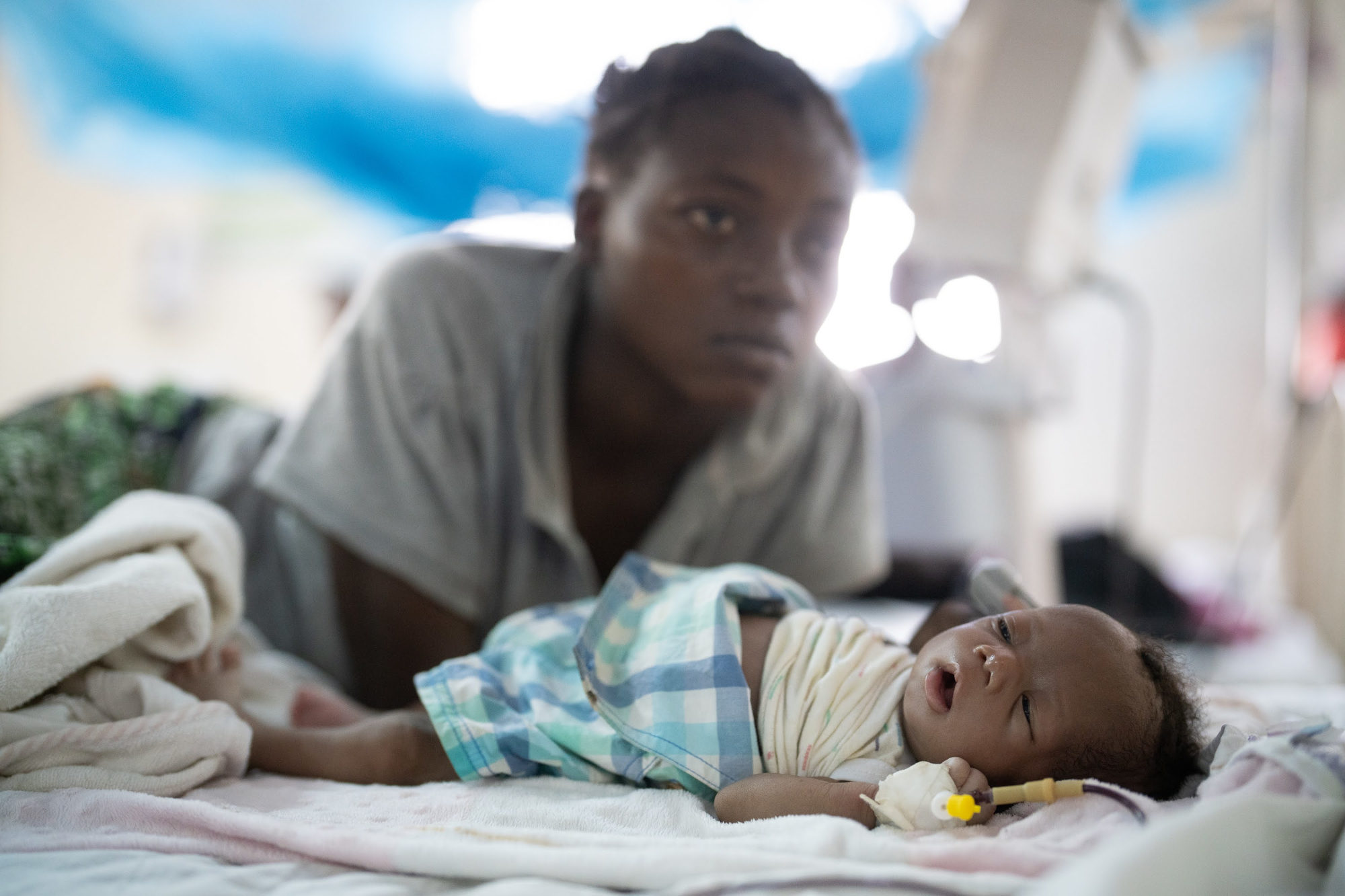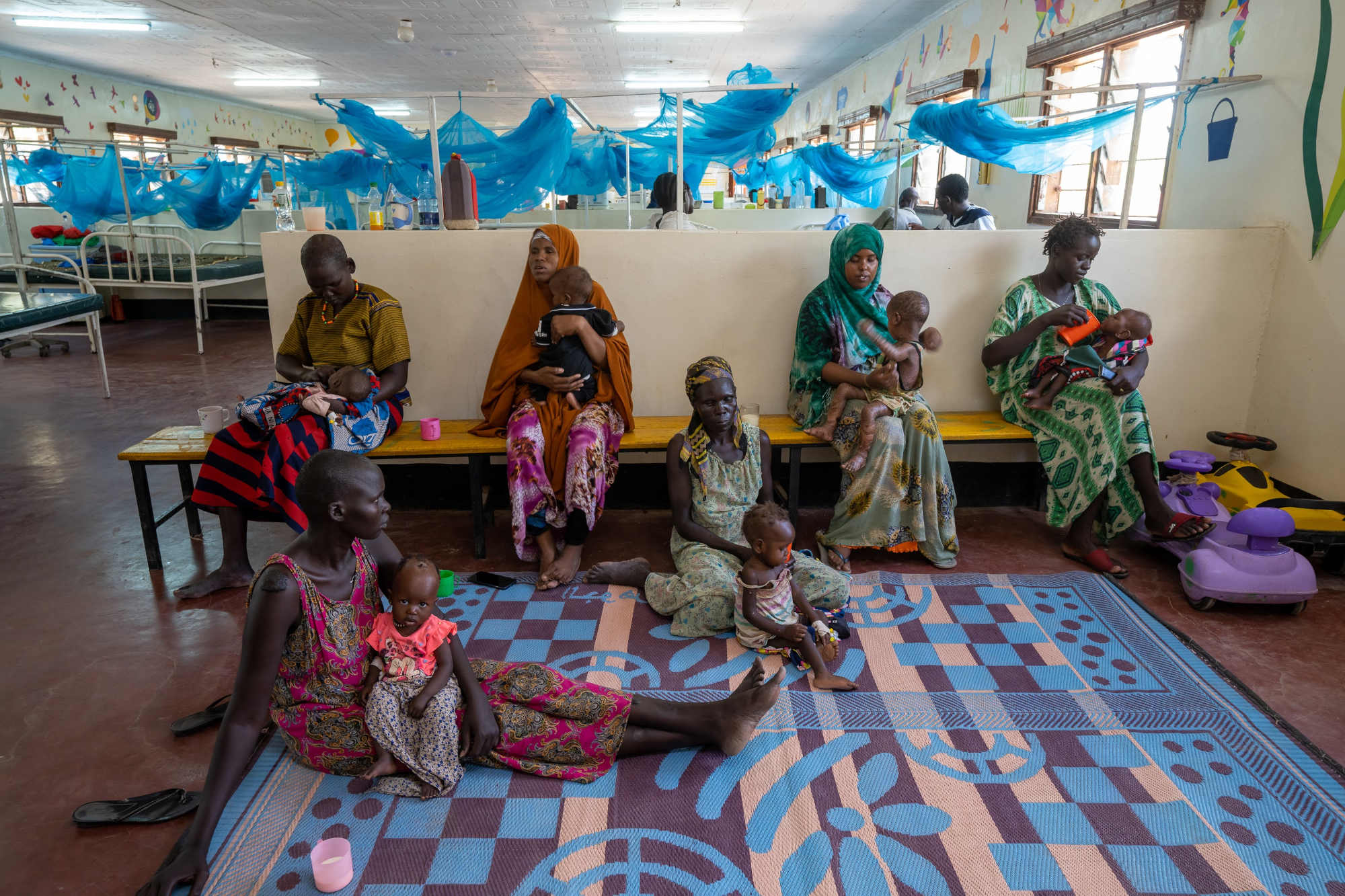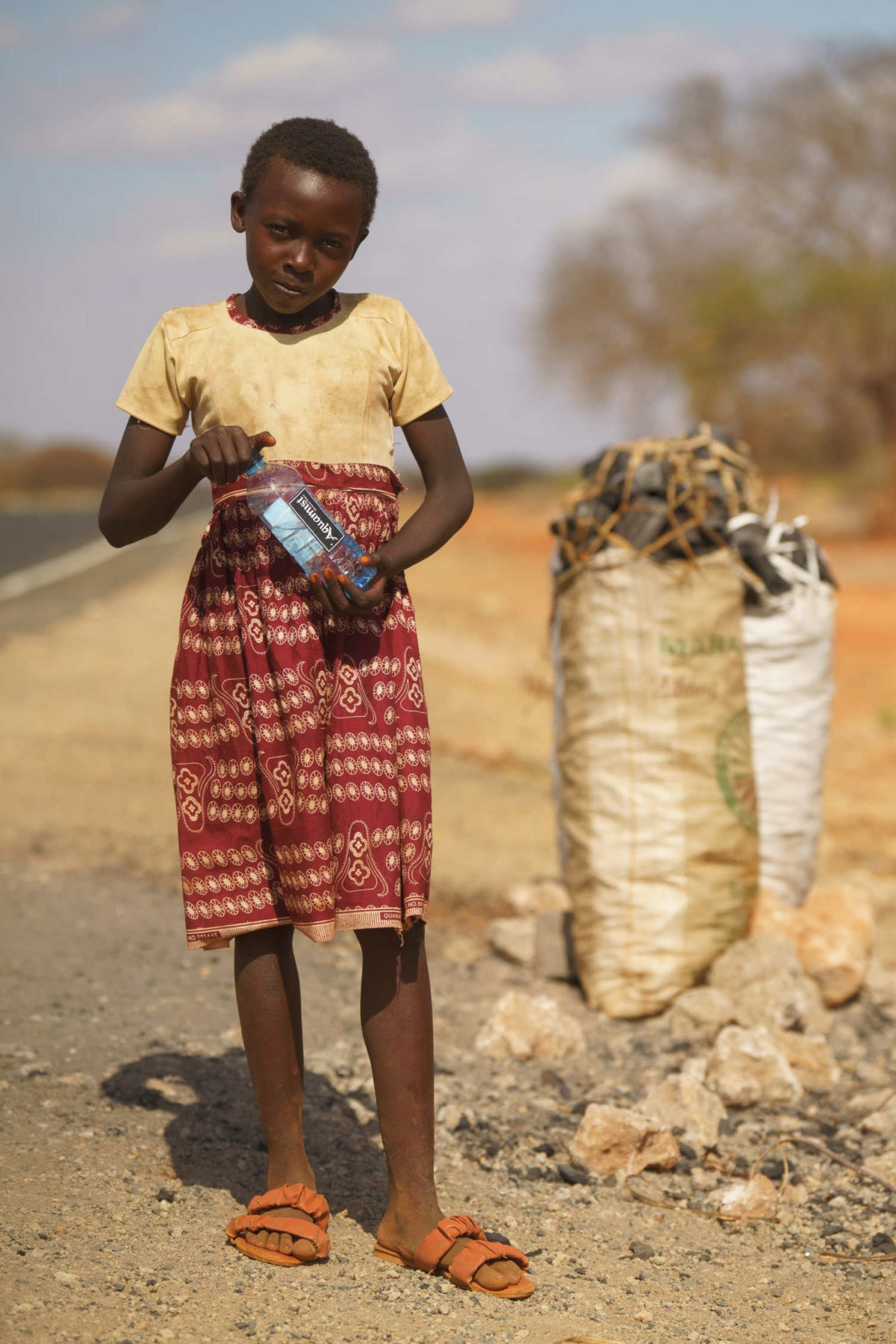In Kenya, an Epidemic of Children Hospitalized for Starvation
The words “Stabilization Ward” are painted in uneven black letters above the entrance, but everyone in this massive refugee camp in Kakuma, Kenya, calls it ya maziwa: The place of milk.
Rescue workers and doctors, mothers and fathers, have carried hundreds of starving children through the doors of this one-room hospital wing, which is sometimes so crowded that babies and toddlers have to share beds. A pediatric unit is only a few steps away, but malnourished children don’t go there. They need special care, and even that doesn’t always save them.
 This story was originally published by Inside Climate News and was supported by the Pulitzer Center on Crisis Reporting.
This story was originally published by Inside Climate News and was supported by the Pulitzer Center on Crisis Reporting.
In an office of the International Rescue Committee nearby, Vincent Opinya sits behind a desk with figures on dry-erase boards and a map of the camp on the walls around him. “We’ve lost 45 children this year due to malnutrition,” he says, juggling emergencies, phone calls, and texts. “We’re seeing a significant increase in malnutrition cases as a result of the drought — the worst we’ve faced in 40 years.”
From January to June, the ward experienced an 800 percent rise in admissions of children under 5 who needed treatment for malnourishment — a surge that aid groups blame mostly on a climate change-fueled drought that has turned the region into a parched barren.
Opinya, the nutrition manager for the IRC here, has had to rattle off these statistics many times, but the reality of the numbers is starting to crack his professional armor. “It’s a very sad situation,” he says, wearily. And he believes it will only get worse. A third year of drought is likely on the way.
More children may die. But millions will survive malnutrition and hunger only to live through a compromised future, researchers say. The longer-term health effects of this drought — weakened immune systems, developmental problems — will persist for a generation or more, with consequences that will cascade into communities and societies for decades.
The Ammusait General Hospital sits in the sprawl of the Kakuma refugee camp, one of the largest in the world. The camp was established in the early 1990s to house refugees fleeing violence in Sudan, but today it’s home to nearly a quarter million people from throughout East and Central Africa. The camp is carved up into sections, each grouping people from certain countries: South Sudanese with Somalis, Ethiopians with Burundians and Ugandans. The hospital, run by the IRC, treats all of them.
Over the past two years, more refugees have fled drought and violence in the chronically unstable countries around Kenya’s perimeter. Millions of people in Ethiopia, Somalia, and South Sudan are already facing catastrophic famine, according to the United Nations. Malnutrition levels in children have reached all-time highs. Doctors, nurses, aides, wards have all been overwhelmed.
“The increase in refugees means an increase in malnutrition here because most of them come in already malnourished,” says Jennifer Katumbi, an IRC nutritionist.
Though technically a hospital for the camp’s refugees, Ammusait has also become the primary hospital for people from the surrounding towns and villages, and is especially critical now as the drought has pushed more of them toward famine.
On a blazing-hot October day, the Stabilization Ward is filled with malnourished children from the refugee camp and from throughout Turkana County. The refugees in the camps are often better off. They, at least, get rations from the U.N.’s World Food Program, or WFP. Alarmingly, those are starting to dwindle, Opinya says.




The WFP is the world’s largest humanitarian organization, but the record number of people near or at famine levels around the globe this year — a spike attributed in large part to climate-related disasters — has stretched the group beyond its capacity.
Sila Monthe, a doctor from Nairobi, oversees the health facilities in the camp, including Ammusait. Today she walks along its covered paths, pointing out the various wings: the maternity ward, radiology, the surgery center. People sit on every available table and chair, many on the ground outside, waiting in clusters with their loved ones for a doctor or nurse to call their name.
“As you can see, it’s a very busy place,” Monthe says.
Inside the Stabilization Ward, Monthe watches as aides and nurses whisk powdered formula into a white frothy “milk” in plastic containers. Shortly after they arrive the children are fed this formula, which comes in a white can with black lettering that reads F-75. After a week or so, they move on to F-100, which has an even higher nutritional content, to help rebuild wasted tissue.
One-year-old Domber Mohamed was admitted to the ward in the early morning hours, severely malnourished and vomiting. The nurses followed a protocol: They warmed him up, gave him glucose, then started the formula.
His mother, Veronica Gabriel, holds Domber as his sister, Lydia, 15, sits nearby. Lydia explains that she fled to the camp with her mother in 2017 from South Sudan “because of war.”
But now something else threatens the family. “The only food we have is rations,” she says. “And we only get it once a day.”
It’s not enough.
The warning is as stark as an F-75 label: The majority of children who die of climate-related causes will do so because of malnutrition, the U.N. says. And 1 billion — half of the planet’s children — live in developing countries that are projected to experience more extreme and unpredictable weather, putting them at greater risk of climate and food shocks.
The risk is not only that children will die because they don’t have access to nutritious food. It’s that they’ll survive but never fully recover.
“They never reach their potential,” says Lynnda Kiess, a senior program advisor for nutrition at the WFP.
The drought here could mean that some children go for months or years without adequate food, leading to a long-term effect of malnutrition known as stunting that prevents children from reaching their full size.
“With stunting, over time, it starts to affect their mental development and their ability to grow,” Monthe explains. “They will be thin and short. They will be more prone to infections and mental development problems. If you have a population that’s stunted, in 10 years, the workforce will be sick.”
The warnings from the U.N. and the Intergovernmental Panel on Climate Change have predicted that child malnutrition will likely rise with climate change, largely because extreme weather or warming temperatures will limit food production or access to food. In Africa, where over 40 percent of the population is under 15, climate change will lead to 1.5 million more stunted children, and that’s if the world manages to keep warming to 2 degrees Celsius (3.6 degrees Fahrenheit).
But recent research makes an even more direct link between extreme heat and malnutrition in children. Looking at weather data from West Africa over a 20-year period, researchers found that exposure to extreme heat increased stunting by 12 percent, and low weight from acute malnutrition — also known as wasting — by nearly 30 percent. The researchers, from Cornell University, found that if global temperatures rise by 2 degrees Celsius, which climate experts expect unless radical steps are taken, stunting rates will double.
“Finally we have a direct connection,” said Molly Elizabeth Brown, a food security and climate expert at the University of Maryland, who was not involved in the study. “Climate change causes temperatures to go up. Higher temperatures cause reduced health outcomes for children under 5. Full stop.”

Still more recent research finds that high temperatures are a bigger driver of child malnutrition than water sanitation, education, or poverty — these being the targets of international development efforts. In other words, warming temperatures, stoked by climate change, have the potential to undo progress already made on reducing child malnutrition or any future progress.
The costs to Kenya or to any other country are barely understood. What hasn’t been completely measured yet — and maybe is immeasurable — is the cost, not only in human suffering, but to societies and economies well beyond the borders of this region.
“When it’s hot out, we worry, but then conditions come back to normal,” said Ariel Ortiz-Bobea, an applied economist with Cornell University, and co-author of the recent research on heat impacts in West Africa. “But when they get these heat shocks, the impacts are irreversible — they last the rest of their lives. That’s tragic. It’s so unjust.”
There is no accurate measurement for a lost future.
The Tigo School rises out of the beige, scrubby horizon, a cluster of seafoam green cinder block buildings, surrounded by chain link fencing.
The 366 children who attend the school, in Marsabit County, east of Turkana, come mostly from nomadic families and different tribes from the region. They live and study here every day of the week. “We are creating a small life in the desert,” says David Denge, the school’s head teacher, sitting at his dusty desk, decorated with a Kenyan flag and equipped with a Dell computer.
The school is a rare place — an oasis for children who might otherwise be going hungry. All of them are victims of the drought in one way or another. Denge hesitates to let them go home, even for breaks.
“Once we send them home, they won’t come back,” he says.
The children’s voices, reciting English phrases, bounce off the concrete walls. At lunchtime, they flood a large room where they wait in lines for porridge. At the end of the day, after their lessons and dinner, they sleep on bunk beds in tidy dorms. Lights out is at 9.
The school is only a few years old, but when these children graduate and take their national exams, Denge hopes they will move on to secondary school, maybe even to a prestigious one like Alliance outside Nairobi. They’ll have opportunities beyond herding, away from a precarious, drought-driven life.





They’re the lucky ones. The school is supported by the aid group Pastoralist Community Initiative and Development Assistance, or PACIDA, and international donors. Unlike government schools, it won’t send kids home even if they can’t pay their fees.
Patrick Katelo, PACIDA’s director, grew up in a pastoralist tribe himself. He knows what that life is like and what education can do, especially now.
“Because of climate change, the only thing to do for these kids is educate them,” he says. “The school is sort of a rescue center. From hunger, from early marriages.”
Attendance rates have dropped at schools across northern Kenya as the drought has persisted and families have lost income. Katelo worries what that will mean for tensions in the area and beyond. The dropouts, he says, will be seduced into joining al-Shabaab, the Somalia-based militant Islamic group that’s active in the region.
“We are a peaceful country, but we have porous borders,” he says.
The school sits along a two-lane highway that stretches across the continent, starting in South Africa and leading to Egypt. Like many highways here, it is a lifeline.

Sarah John sells charcoal on the A3 highway west of Garissa County.
People sit under the shade of trees and run to the edge when a rare car passes by, waving yellow water jugs or their arms, hoping to slow anyone down. Parents, who can’t afford to send their children to school, send them to the road to plead for water instead.
Sarah John, a bubbly, enterprising 12-year-old who lives in neighboring Garissa County, wishes she was in classes with her friends. But her parents, like so many others now, don’t have the money to pay her fees. There are only so many Tigo Schools. She spends her days now flagging down vehicles for water.
“I saw another girl doing it,” she says, “so I started doing it.”
She holds up two, then three fingers to show how many water bottles passersby give to her in a given day. Then she runs to the edge of the road as a truck approaches, waving an empty bottle, signaling the driver to stop. This one doesn’t. She traces the yellow lines of the highway as the truck grumbles quickly past, heading north. She steps back from the road’s edge and waits for the next one.
To reach the pediatric wing of the Marsabit County Referral Hospital, nurses, doctors, and visitors walk past buildings with cracked and shattered windows, a defunct ambulance without tires and scowling baboons that seem to be waiting for something to go wrong.
Unlike Ammusait, hundreds of miles to the northwest, this small county hospital doesn’t have a ward dedicated to stabilizing starving children. It has only the “malnutrition room.”
Today, tiny 7-year-old Ibrae Guyo is its sole occupant.
The boy lives with his mother, a herder, out in the endless, windblown desert beyond the town, a landscape littered with bones and empty water bottles. When his health started to decline, a relative brought him here, though it’s not quite clear who and how. He was suffering from brucellosis, malaria, and malnutrition, barely responsive and dying, the doctors said.
The nurses are shocked he’s still alive.
“I admitted him,” said Bite Konte, the nurse in charge of the unit. “I didn’t think he was going to make it.”
After a week of treatment, the boy began to recover and the other day he smiled for the first time. His mother arrived this morning. She had stayed behind to safeguard the family’s animals, but when the last one died she walked more than 30 miles to the nearest town and then got a ride to Marsabit in a communal truck.
“I never thought I’d see him alive again,” she says, so exhausted herself she can barely speak or express her relief. Her spindly frame is draped in thin cloth that hangs off her bony joints.
The doctors and nurses at these hospitals refer to the spike in cases earlier this year as “the surge,” attaching a label to it like a traumatic historic event, a deadly battle.
“During the surge, in the stabilization center, monitoring was a challenge,” says Hildah Kemboi, a clinical pediatric officer with the IRC. “I was exhausted all the time. When a caretaker loses a patient, it’s very difficult to accept the situation.”
But it’s almost as hard to watch a child recover and cycle back in again and again. “You stabilize a patient and then they’re back in a week,” Kemboi says.

By October, the number of malnourished children coming into these hospitals has slowed. Some nurses worry it’s not because things are getting better, but because parents aren’t bothering to bring their children in anymore.
“Most people have given up on the hospital. They can’t pay the bills,” says Martha Jakinda, a nurse at the Marsabit hospital. “They just die at home.”
Out in the desert, the only sounds are of camel bells and herder calls and the wind. In the pediatric ward, children cry, monitors bleep, shoes click on tile. Ibrae sits on his bed, his legs dangling off the edge, his feet in little brown sandals. His black eyes sparkle in the dim light coming through the window.
He will spend 36 days here. Then he’ll go back to the desert, where every living thing waits for rain.
Victoria St. Martin contributed reporting.
Georgina Gustin covers agriculture for Inside Climate News, and has reported on the intersections of farming, food systems, and the environment for much of her career. Her work has appeared in The New York Times, Washington Post, and National Geographic’s The Plate, among others.
Larry C. Price is a two-time Pulitzer Prize-winning documentary photographer and multimedia journalist based in Dayton, Ohio. He previously produced award-winning photography and video footage for Undark’s Breathtaking series on air pollution, which won a George Polk Award for Environmental Reporting in 2018.
This story was produced in partnership with the Pulitzer Center and with Inside Climate News, a nonprofit, independent news organization that covers climate, energy and the environment. Sign up for the ICN newsletter here.










